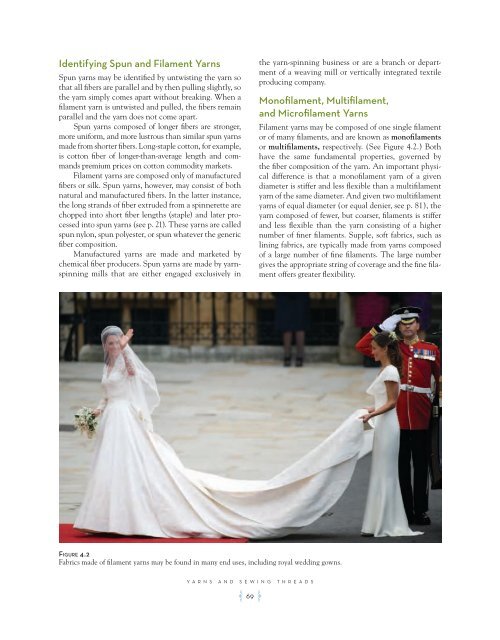Create successful ePaper yourself
Turn your PDF publications into a flip-book with our unique Google optimized e-Paper software.
Identifying Spun and Filament Yarns<br />
Spun yarns may be identified by untwisting the yarn so<br />
that all fibers are parallel and by then pulling slightly, so<br />
the yarn simply comes apart without breaking. When a<br />
filament yarn is untwisted and pulled, the fibers remain<br />
parallel and the yarn does not come apart.<br />
Spun yarns composed of longer fibers are stronger,<br />
more uniform, and more lustrous than similar spun yarns<br />
made from shorter fibers. Long-staple cotton, for example,<br />
is cotton fiber of longer-than-average length and commands<br />
premium prices on cotton commodity markets.<br />
Filament yarns are composed only of manufactured<br />
fibers or silk. Spun yarns, however, may consist of both<br />
natural and manufactured fibers. In the latter instance,<br />
the long strands of fiber extruded from a spinnerette are<br />
chopped into short fiber lengths (staple) and later processed<br />
into spun yarns (see p. 21). These yarns are called<br />
spun nylon, spun polyester, or spun whatever the generic<br />
fiber composition.<br />
Manufactured yarns are made and marketed by<br />
chemical fiber producers. Spun yarns are made by yarnspinning<br />
mills that are either engaged exclusively in<br />
YARNS AND SEWING THREADS<br />
A 69 F<br />
the yarn-spinning business or are a branch or department<br />
of a weaving mill or vertically integrated textile<br />
producing company.<br />
Monofilament, Multifilament,<br />
and Microfilament Yarns<br />
Figure 4.2<br />
<strong>Fabrics</strong> made of filament yarns may be found in many end uses, including royal wedding gowns.<br />
Filament yarns may be composed of one single filament<br />
or of many filaments, and are known as monofilaments<br />
or multifilaments, respectively. (See Figure 4.2.) Both<br />
have the same fundamental properties, governed by<br />
the fiber composition of the yarn. An important physical<br />
difference is that a monofilament yarn of a given<br />
diameter is stiffer and less flexible than a multifilament<br />
yarn of the same diameter. And given two multifilament<br />
yarns of equal diameter (or equal denier, see p. 81), the<br />
yarn composed of fewer, but coarser, filaments is stiffer<br />
and less flexible than the yarn consisting of a higher<br />
number of finer filaments. Supple, soft fabrics, such as<br />
lining fabrics, are typically made from yarns composed<br />
of a large number of fine filaments. The large number<br />
gives the appropriate string of coverage and the fine filament<br />
offers greater flexibility.













